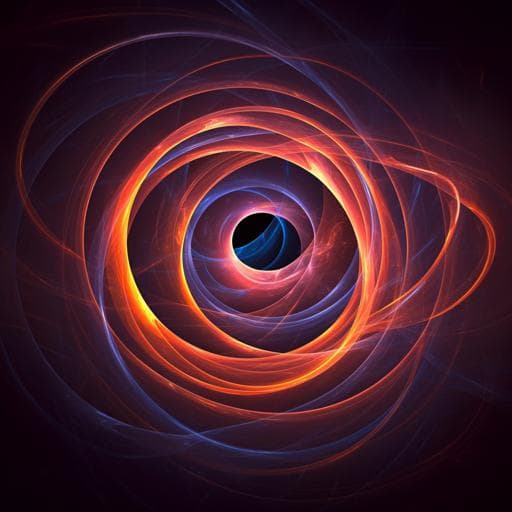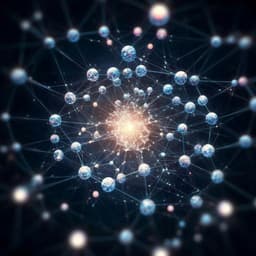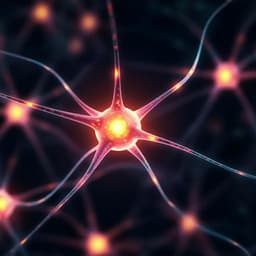
Physics
Spatiotemporal optical vortices with controllable radial and azimuthal quantum numbers
X. Liu, Q. Cao, et al.
This research by Xin Liu, Qian Cao, Nianjia Zhang, Andy Chong, Yangjian Cai, and Qiwen Zhan explores optical spatiotemporal vortices with unique multi-ring topology and composite transverse orbital angular momentum. Discover the innovative mode conversion techniques that facilitate efficient wavepacket recognition, paving the way for advancements in quantum information and nonlinear optics!
~3 min • Beginner • English
Introduction
The study addresses how to generate, control, and characterize spatiotemporal optical vortices that possess both radial (p) and azimuthal (l) quantum numbers, extending beyond conventional spatiotemporal optical vortices (STOVs) that typically employ Gaussian-type modes. Prior work established longitudinal OAM in spatial optical vortices and transverse OAM in STOVs. However, spatiotemporal Laguerre-Gaussian (STLG) modes with independently controllable p and l remain underexplored. The purpose is to synthesize high-purity STLG wavepackets, reveal their topological and angular-momentum properties (including composite transverse OAM), and demonstrate deterministic mode conversion to spatiotemporal Hermite-Gaussian (STHG) modes using spatiotemporal astigmatism. This is important for advancing high-dimensional encoding, photonic topology, ultrafast structured light control, and cross-domain wave phenomena.
Literature Review
The paper surveys the evolution from spatial optical vortices with longitudinal OAM (e.g., Laguerre-Gaussian beams) to spatiotemporal optical vortices carrying transverse OAM synthesized via spectral–spatial phase engineering. It highlights extensive applications of OAM beams in manipulation, quantum information, communications, and holography. Recent ultrafast optics enabled self-torque beams with time-varying OAM. Breakthroughs in STOV generation and propagation have propelled research in photonic topology, structured ultrafast wavepackets, nonlinear optics, and nanophotonics, including extensions to acoustics and electrons. LG and HG modes form complete, orthonormal spatial bases, with LG characterized by azimuthal (l) and radial (p) indices; p relates to hyperbolic momentum and remains comparatively underutilized. Prior works emphasize Gaussian-type STOVs; the literature lacks systematic exploration of space–time coupled LG modes with both p and l, motivating this study.
Methodology
Theory and simulations: The pulsed field is modeled as E(t,x,y,z)=ψ(t,x,y,z)exp(iω0 t−ik0 z). Under scalar, paraxial, narrowband approximations in a dispersive medium, the envelope ψ satisfies a mixed space–time paraxial equation coupling transverse diffraction with group-velocity dispersion (GVD). In anomalous GVD with β2=k0, closed-form spatiotemporal Laguerre-Gaussian (STLG) solutions exist. Synthesis is achieved by launching a spatial–spectral coupled, polychromatic LG seed beam whose complex amplitude encodes LG radial and azimuthal structure across frequency and transverse coordinates. With properly balanced spatial diffraction and temporal dispersion, the propagation maps the seed into an STLG wavepacket characterized by indices (p,l), multi-ring topology, screw singularities and edge dislocations, and an intrinsic transverse OAM that is a composite of oppositely directed components. Numerical simulations illustrate synthesis for p=1, l=+2 at 1.03 µm, spectral width 8 rad/ps, and positive GDD α≈9500 fs², yielding a wavepacket with spatial width ~0.8 mm and temporal width ~182 fs at L=800 mm. The STLG is an exact solution and exhibits self-similarity in a diffraction–dispersion matched medium. Mode conversion theory adapts spatial LG–HG astigmatic conversion to space–time: applying controlled spatiotemporal astigmatism maps STLG to STHG. Simulations show progressive deformation and singularity dislocation with increasing astigmatism, culminating in STHG with orders determined by p and l; neighboring lobes have π phase differences.
Experimental synthesis: A 2D ultrafast holographic pulse shaper integrates a grating, a cylindrical lens, and a phase-only reflective SLM placed in the spatial–spectral plane to realize complex-amplitude modulation via a computer-generated hologram (CGH). The CGH includes: (1) phase of a spatial–spectral LG mode; (2) a GDD phase to pre-chirp and balance diffraction/dispersion; (3) a phase grating whose depth is modulated by the target mode modulus to realize amplitude control while routing undesired energy away; and (4) an astigmatic phase for ST astigmatism. The chirped input pulse is spectrally dispersed along y, mapped onto the SLM, then recombined to form the space–time coupled wavepacket after free-space propagation to a plane where diffraction and dispersion balance to realize the STLG.
Setup details: A mode-locked fiber laser centered at 1030 nm with ~20 nm bandwidth provides the object and probe pulses. The probe is de-chirped to ~122 fs using a parallel grating compressor and prism. The object pulse enters the pulse shaper: reflective grating (1200 lines/mm) disperses spectrum, cylindrical lens (f=10 cm, y-axis) collimates onto an SLM (Holoeye GAEA-2, 3840×2160 pixels, 3.74 µm pitch). The SLM encodes the CGH; after reflection and recombination, the STLG forms ~1.2 m downstream. Only the zeroth diffraction order is passed to avoid spatial dispersion artifacts.
Characterization: A 3D diagnostic based on off-axis interferometry with a time-delayed Fourier-transform-limited probe reconstructs the complex spatiotemporal field. By scanning delay (100 frames, ~33 fs step), the full 3D intensity and sliced phase are retrieved. Modal purity is quantified via projection onto LG bases exploiting orthonormality. Spatiotemporal astigmatism is implemented holographically to convert STLG to STHG; spatial projection imaging with a slow detector validates decoupled space–time intensity and enables recognition of p and l via the number of spatial dark gaps under positive/negative astigmatism.
Hologram calibration and constraints: The phase-only SLM is calibrated to linear 2π phase at 1030 nm across 256 gray levels. The amplitude-encoding phase grating diffracts residual unwanted energy. Spatial–spectral bandwidth of the input pulse and SLM resolution jointly limit the maximum achievable mode order.
Key Findings
- Theory identifies STLG wavepackets as exact solutions of the paraxial dispersive equation under β2=k0, with controllable radial (p) and azimuthal (l) indices. Their transverse OAM is composite, formed by two oppositely directed components due to the multi-ring topology from nonzero p.
- Numerical synthesis of STLG (p=1, l=+2) at λ0≈1.03 µm with spectral width ~8 rad/ps and GDD α≈9500 fs² produces a wavepacket at L=800 mm with spatial width ~0.8 mm and temporal width ~182 fs. The spatiotemporal phase shows a central l=+2 vortex core surrounded by p rings with π phase alternation.
- Spatiotemporal astigmatism enables deterministic mode conversion from STLG to STHG. Simulations show full mapping at astigmatism μ0≈0.625 fs/(rad·mm), yielding STHG with spatial width ~3.5 mm and temporal width ~177 fs; lobe patterns follow p and l, with π phase steps between neighboring lobes. Conversion rules: for positive l, time order p+l and space order p; for negative l, time order p and space order p−l (consistent with Supplementary theory).
- Experimental reconstruction of STLG with p=2, l=+1 confirms multi-ring “flying donut” topology and spiral phase. Measured accumulated intensity and sliced phase at y=0 show two outer rings (p=2) with π phase difference and azimuthal phase winding (l=+1). Fitted spatial and temporal widths are ~1.4 mm and ~300 fs. Modal weight analysis shows ~35.7% power in the target mode (p=2, l=+1), with remaining power in neighboring modes.
- Additional STLG modes experimentally synthesized include p=1, l=0; p=1, l=+1; p=1, l=+2; p=2, l=0, all showing expected multi-ring structures.
- Experimental STLG→STHG conversion demonstrated for p=0, l=+5, producing an STHG with l+1=6 temporal lobes with ~π phase differences and ~250 fs temporal pitch at spatiotemporal astigmatism strength ~15 fs/(rad·mm). Multiple converted STHG indices were realized, and the conversion dynamics (singularity separation, ring collapse) match simulations.
- Spatial intensity projections of STHG under positive/negative astigmatism reveal decoupled space–time intensity, enabling efficient recognition of STLG quantum numbers: for μ·l>0, number of dark gaps along x equals N=p (TEMN0); for μ·l<0, it equals M=p+1 (TEMM0). A counting scheme maps measured M,N to l=N−M and p=min(M,N).
Discussion
The work demonstrates that spatiotemporal LG wavepackets with controllable radial and azimuthal indices can be synthesized and measured with high fidelity using 2D holographic pulse shaping, addressing the gap in STOV research that largely focused on Gaussian modes. The results validate key theoretical predictions: STLGs exhibit screw singularities and edge dislocations in space–time and carry composite transverse OAM arising from their radial structure. The ability to convert STLGs into STHGs via spatiotemporal astigmatism and the decoupling of spatial and temporal intensity enable independent control and practical recognition of mode indices, which is valuable for ultrafast information encoding, high-dimensional quantum photonics, and topology-driven light–matter interactions. The confirmed self-similarity under matched diffraction–dispersion suggests robustness for propagation in tailored media. Overall, the findings broaden the toolbox for space–time structured light, linking complete STLG and STHG bases and opening pathways for scalable mode engineering and detection.
Conclusion
The paper reports the first experimental synthesis of spatiotemporal Laguerre–Gaussian wavepackets with tunable radial (p) and azimuthal (l) quantum numbers and verifies their characteristic multi-ring topology, screw singularities, and composite transverse OAM. Using a 2D pulse shaper that implements precise spatial–spectral complex-amplitude modulation, the authors generate high-purity STLGs and quantitatively characterize their full 3D field. They further achieve deterministic conversion to spatiotemporal Hermite–Gaussian wavepackets via controllable spatiotemporal astigmatism, establishing practical links between two complete mode bases in space–time. Future research directions include: scaling to ultra-high-order modes through increased spatial–spectral bandwidth and improved holographic devices; low-loss implementations using nanophotonic platforms; robust, high-speed sorting and recognition of (p,l) for communications and quantum information; and extending these concepts to other wave systems (acoustics, electrons) and nonlinear regimes.
Limitations
- Energy efficiency: The complex-amplitude modulation using a phase-only SLM diffracts unwanted energy out of the signal, leading to inherent loss similar to recent STOV methods. Nanophotonic implementations could mitigate this.
- Mode order scalability: Achievable p and l are constrained by the input pulse’s spatial–spectral bandwidth and SLM resolution/pixel pitch, limiting ultra-high-order STLG generation.
- Measurement stability: Off-axis interferometric phase retrieval can suffer from phase fluctuations due to mechanical and alignment instabilities; temporal phase normalization is required and may introduce errors, particularly for STHG with x-parallel phase jumps.
- Propagation broadening: Far-field synthesis introduces spatial/temporal broadening. Without matched GVD during propagation, STLGs can degenerate into lobed structures.
- Modal purity: While substantial, the measured modal purity (~35.7% in the target mode for p=2, l=+1) indicates admixtures with neighboring modes, which may affect applications requiring extremely high purity.
- Conversion fidelity: Accurate ST astigmatism strength is needed for ideal STLG→STHG mapping; mismatch causes singularity displacement and partial conversion.
Related Publications
Explore these studies to deepen your understanding of the subject.







